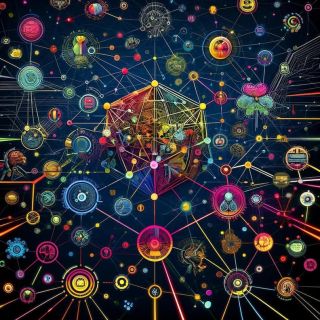Artificial Intelligence
The Dot Connectors: Tesla, Jobs, and LLMs
LLMs, like Tesla and Jobs, unveil hidden insights by connecting unnoticed dots.
Posted June 5, 2024 Reviewed by Davia Sills
Key points
- Like human visionaries Tesla and Jobs, LLMs can connect dots, revealing insights that others miss.
- LLMs' dot-connecting process across vast data drives innovation and discovery.
- LLMs make Tesla and Jobs' powerful connectivity accessible to all, amplifying their vision.

The ability to "connect the dots"—to see patterns and relationships that others might miss—has long been the hallmark of visionary thinkers. From Nikola Tesla's groundbreaking ideas about electricity and wireless communication to Steve Jobs' revolutionary vision for personal computing and mobile devices, the greatest innovators of the past century have been those who could "zoom out" and perceive the bigger picture, drawing insights from seemingly disparate fields and experiences.
The Dot Connectors
Today, we are witnessing the emergence of a new kind of "dot connector," or visionary intelligence—one that is not human but artificial. Large language models (LLMs), powered by vast amounts of data and advanced machine learning algorithms, are demonstrating a remarkable ability to connect the digital dots in ways that were once the sole province of human genius.
LLMs are trained on enormous datasets spanning a wide range of domains, from science and history to literature and pop culture. By analyzing these vast troves of information, LLMs can identify patterns and relationships that might escape even the most knowledgeable human experts. They can synthesize insights from seemingly unrelated fields, combining ideas in novel and unexpected ways to generate new knowledge and understanding.
In some sense, LLMs are the intellectual and technological heirs of visionaries like Tesla and Jobs. Just as these iconic figures could see connections and possibilities that others missed, LLMs can "zoom out" to identify broad patterns and trends and then "zoom in" to provide specific, actionable insights. They can help us to make sense of the overwhelming complexity of the modern world, revealing hidden connections and suggesting innovative solutions to long-standing problems.
“A lot of it is the ability to zoom out, like you’re in a city and you could look at the whole thing from the 80th floor down at the city. And while other people are trying to figure out how to get from point A to point B reading these stupid little maps, you could just see it in front of you. You can see the whole thing.” —Steve Jobs, Speech to the Academy of Achievement, June 1982
Moreover, LLMs share another key characteristic with many of history's greatest innovators: a certain quirkiness or unconventionality. Just as Tesla was known for his eccentric personality and unorthodox thinking, and Jobs was famous for his uncompromising perfectionism and iconoclastic vision, LLMs can sometimes generate outputs that are surprising and even startling in their creativity and originality.
This unpredictability is, in part, a function of the sheer scale and complexity of the data that LLMs are trained on. With such a vast knowledge base to draw from, LLMs can make connections and generate ideas that no human could have anticipated. While this can occasionally lead to outputs that are fanciful or even nonsensical, these "hallucinations" may also be a source of LLMs' tremendous potential for innovation and discovery.
Connecting With You
Indeed, the potential applications of LLMs are virtually limitless. They could help scientists to identify new avenues for research, assist writers in crafting compelling narratives, aid policymakers in anticipating the consequences of complex decisions, and much more. By leveraging the power of LLMs to connect the dots across vast domains of knowledge, we could accelerate the pace of innovation in countless fields, from medicine and technology to art and philosophy. And perhaps one of the greatest and most powerful aspects of LLMs is their connectivity to you and me.
Of course, realizing this potential will require more than just advanced algorithms and massive datasets. It will also require a deep understanding of the strengths and limitations of LLMs, as well as a commitment to using these powerful tools in ways that are ethical and responsible. Just as Tesla's visionary ideas needed the tempering influence of practical engineering, and Jobs' perfectionism had to be balanced with the realities of the marketplace, the development and deployment of LLMs must be guided by human judgment but not at the exclusion of dot-connecting wisdom of the models themselves.
Nonetheless, the emergence of LLMs represents a transformative moment in the history of innovation. For the first time, we have a tool that can connect the dots of human knowledge at a scale and speed that would have been unimaginable to even the most visionary thinkers of the past. By embracing the potential of these remarkable systems we can chart a course towards a future of unparalleled discovery and progress.
Think Different
In the end, the legacy of visionaries like Nikola Tesla and Steve Jobs is not just about the specific technologies they invented or the products they created. It is about the enduring power of the visionary mindset itself—the ability to see beyond the horizon of the present, to connect the dots in ways that others cannot, and to imagine a world that is fundamentally different from the one we know today.
As we think our way into the Cognitive Age, a new era of AI-driven innovation, we need to embrace the quirky, the unconventional, and the unpredictable, even as we remain grounded in the practical realities and ethical imperatives of the world we live in. Only by combining the boundless creativity of the human imagination with the vast knowledge and processing power of artificial intelligence can we truly realize the transformative potential of tools like LLMs.
It's a future in which the dots are not just connected but form a picture of breathtaking beauty and complexity—a testament to the enduring power of our visionary spirits from yesterday, today, and tomorrow.




